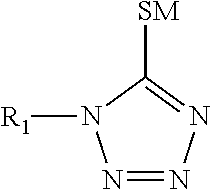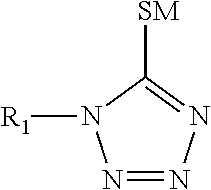Electroplating baths of silver and tin alloys
a technology of electroplating bath and tin alloy, which is applied in the direction of basic electric elements, semiconductor devices, electrical equipment, etc., can solve the problems of low electrical contact resistance required, limiting low cost contact finishes, and increasing gold price, so as to achieve uniform morphology and sufficient hard replacemen
- Summary
- Abstract
- Description
- Claims
- Application Information
AI Technical Summary
Benefits of technology
Problems solved by technology
Method used
Image
Examples
example 1
[0053]A plurality of silver rich silver / tin alloy electroplating baths were prepared having the two formulations in the table below.
[0054]
TABLE 1COMPONENTFORMULATION IFORMULATION IISilver ions from silver 60 g / L 60 g / Lmethane sulfonateTin ions from tin methane 15 g / L 15 g / LsulfonateMethane sulfonic acid162 g / L162 g / L1-(2-Dimethylaminoethyl)-150 g / L150 g / L5-mercapto-1,2,3,4-tetrazole3,6-dithiaoctane-1,8-diol 22 g / L04,4-thiodiphenol0 2 g / LAmine oxide surfactant 3 g / L 3 g / LHydroquinone 1.2 g / L 1.2 g / L monosulfonic acid,potassium salt
[0055]Electrolysis of formulation I was then performed. The test was done to show the electrochemical stability of the bath. A brass panel 7.5 cm×10 cm was weighed and then secured in the plating tank. A low current density of 2 ASD was applied to the panel for 15 minutes. The panel was removed from the plating tank and weighed. The amount of silver / tin plated during the 15 minutes was determined. The quantity of electricity was also recorded in ampere hou...
example 2
[0057]The two formulations in Table 1 were used to electroplate a silver / tin alloy on brass, copper, copper / beryllium alloy, copper / nickel alloy, copper / tin alloy, nickel coated brass and nickel coated copper panels. Each panel was 7.5 cm×10 cm. The thickness of the panels was 0.25 mm. The nickel coated brass and nickel coated copper panels contained a silver strike layer of less than 100 nm to promote adhesion of the silver / tin layer to the nickel. The silver strike layer had been electroplated on the panels using a silver strike bath containing 2 g / L silver ions, 15 g / L 3,6-dithia-1,8-octanediol, 67 g / L methane sulfonic acid. Electroplating had been done for 0.5 ASD to 1 ASD for 10 seconds to 30 seconds.
[0058]The panels were placed in plating tanks containing either Formulation I or Formulation II. The temperatures of the baths were 50° C. and the anode was an iridium oxide insoluble anode. Each electrode was connected to a rectifier. Electroplating was done at 2 ASD. After the pa...
example 3
[0059]A brass cylinder 12 mm in diameter and 8 mm in height was mounted on the axis of an electrical motor and immersed in a plating bath containing Formulation I in Table 1. The motor was set to a rotation speed of 1000 rpm. An insoluble iridium oxide electrode was used as the anode. The electrodes were connected to a rectifier. The electroplating bath was agitated through rotation of the cathode and the bath temperature was maintained at 50° C. Electroplating was done at 0.5, 1, 2, 4, 6, 8, 10, 12, 14, 16, 18 and 20 ASD. The cylinder was changed when moving from one current density to another and the plating time was adjusted to keep the same film thickness. All of the silver / tin alloy deposits had a bright, shiny appearance over the current density range from 0.5 ASD to 16 ASD. Small burned edges were observed at 18 ASD and 20 ASD.
[0060]The silver and tin content of each deposit was determined by X-ray fluorescence (XRF) analysis using a FISCHERSCOPE X-Ray model XDV-SD from Helmu...
PUM
| Property | Measurement | Unit |
|---|---|---|
| weight ratio | aaaaa | aaaaa |
| weight ratio | aaaaa | aaaaa |
| current density | aaaaa | aaaaa |
Abstract
Description
Claims
Application Information
 Login to View More
Login to View More - R&D
- Intellectual Property
- Life Sciences
- Materials
- Tech Scout
- Unparalleled Data Quality
- Higher Quality Content
- 60% Fewer Hallucinations
Browse by: Latest US Patents, China's latest patents, Technical Efficacy Thesaurus, Application Domain, Technology Topic, Popular Technical Reports.
© 2025 PatSnap. All rights reserved.Legal|Privacy policy|Modern Slavery Act Transparency Statement|Sitemap|About US| Contact US: help@patsnap.com



